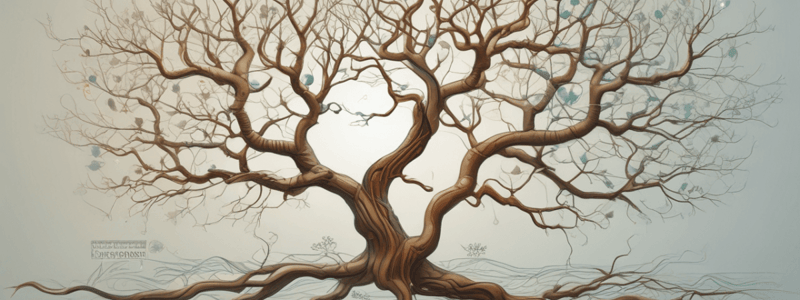Podcast
Questions and Answers
Which of the following branches of biology focuses on the study of the interactions between organisms and their environment?
Which of the following branches of biology focuses on the study of the interactions between organisms and their environment?
- Zoology
- Genetics
- Ecology (correct)
- Botany
What is the primary function of the cell membrane?
What is the primary function of the cell membrane?
- Storing genetic information
- Synthesizing proteins
- Producing energy for the cell
- Regulating the passage of substances into and out of the cell (correct)
Which of the following is NOT a characteristic of life?
Which of the following is NOT a characteristic of life?
- Organization
- Growth and Development
- Movement (correct)
- Reproduction
What is the process by which individuals with advantageous traits are more likely to survive and reproduce called?
What is the process by which individuals with advantageous traits are more likely to survive and reproduce called?
What is the study of heredity and variation called?
What is the study of heredity and variation called?
Which of these processes is responsible for the formation of gametes (sperm and egg cells)?
Which of these processes is responsible for the formation of gametes (sperm and egg cells)?
What is the process called where new species emerge from existing ones?
What is the process called where new species emerge from existing ones?
Which of the following is NOT a branch of biology?
Which of the following is NOT a branch of biology?
Flashcards are hidden until you start studying
Study Notes
Biology Definition
- Biology is the scientific study of life and living organisms, including their structure, function, growth, evolution, and interactions with the environment.
Branches of Biology
- Botany: study of plants
- Zoology: study of animals
- Microbiology: study of microorganisms (bacteria, viruses, etc.)
- Ecology: study of interactions between organisms and their environment
- Genetics: study of heredity and variation
- Biochemistry: study of chemical processes in living organisms
- Molecular Biology: study of biological molecules and their interactions
Characteristics of Life
- Organization: living organisms are composed of cells, tissues, and organs
- Metabolism: living organisms carry out chemical reactions to sustain life
- Homeostasis: living organisms maintain a stable internal environment
- Growth and Development: living organisms increase in size and complexity
- Reproduction: living organisms produce offspring
- Response to Stimuli: living organisms react to changes in their environment
- Evolution: living organisms change over time through genetic variation and natural selection
Cellular Biology
- Cell Structure: cells are the basic units of life, consisting of a nucleus, cytoplasm, and cell membrane
- Cell Functions: cells perform functions such as metabolism, growth, and reproduction
- Cell Division: cells divide through mitosis (growth and repair) or meiosis (gamete formation)
Evolutionary Biology
- Theory of Evolution: all living organisms share a common ancestor and have evolved over time through natural selection and genetic variation
- Natural Selection: process by which individuals with favorable traits are more likely to survive and reproduce
- Speciation: process by which new species emerge from existing ones
Biology Definition
- Scientific study focusing on life and living organisms.
- Encompasses structure, function, growth, evolution, and environmental interactions.
Branches of Biology
- Botany: Examines plant life, including physiology, structure, and distribution.
- Zoology: Focuses on the biology of animals, including behavior and classification.
- Microbiology: Investigates microorganisms like bacteria and viruses, their roles, and impact.
- Ecology: Studies how organisms interact within their ecosystems and the environment.
- Genetics: Explores heredity, variation, and the molecular basis of genetic traits.
- Biochemistry: Analyzes chemical processes within and related to living organisms.
- Molecular Biology: Looks at biological molecule interactions, including DNA, RNA, and proteins.
Characteristics of Life
- Organization: Composed of cells, forming tissues and organs, demonstrating structural complexity.
- Metabolism: Chemical reactions that convert food into energy necessary for life.
- Homeostasis: Regulation of internal environments to maintain stable conditions despite external changes.
- Growth and Development: Progression from simpler to more complex forms, involving size and functional increase.
- Reproduction: Ability of organisms to produce offspring, ensuring species continuity.
- Response to Stimuli: Ability to react to environmental changes, critical for survival.
- Evolution: Genetic changes over time lead to adaptation and species diversity through natural selection.
Cellular Biology
- Cell Structure: Fundamental life units comprising nucleus, cytoplasm, and cell membrane.
- Cell Functions: Carry out life processes, including metabolism, production, and growth.
- Cell Division: Mitosis for somatic cell growth and repair; meiosis for gamete production leading to sexual reproduction.
Evolutionary Biology
- Theory of Evolution: All species share a common ancestry, evolving through mechanisms such as natural selection.
- Natural Selection: Survival and reproduction of individuals best suited to their environment based on advantageous traits.
- Speciation: Formation of new species from existing species due to evolutionary processes and genetic divergence.
Studying That Suits You
Use AI to generate personalized quizzes and flashcards to suit your learning preferences.




